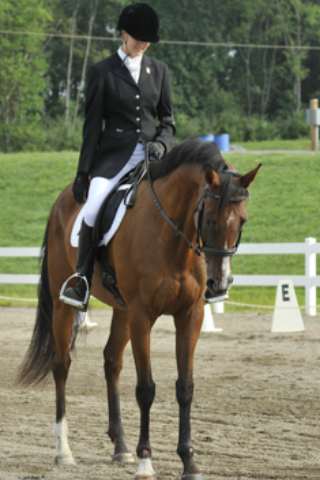Shortly after Carin Brown brought her mare Hermosa Valor home, she started noticing mysterious wounds appearing on the mare’s front legs.
But as soon as they began to heal, the pretty mare would somehow cut them open again.
Then, on a day filled with anticipation and hope for a possible ribbon at the dressage championship for Pony Club, Brown watched with shock as Hermosa Valor her completely collapsed to the stall floor, then seemed to become startled, and scampered back to her feet.
Brown’s local veterinarian was called and a short time later, and the 18-year-old year old ex-racehorse was diagnosed with the very rare condition, equine narcolepsy, Brown had reported about to Off-Track Thoroughbreds.com in an earlier article.
In this week’s Veterinary Answers, Steve Reed DVM Dipl. ACVIM, and shareholder at Rood & Riddle Equine Hospital answers questions about the condition.
Q: I recently wrote about a horse who was diagnosed with equine narcolepsy. It went undetected until the owner saw her horse fall in his stall. How rare is this condition, and what is it?
Narcolepsy is a fairly rare condition. However horses collapsing in stalls have to be separated from sleep deprivation or seizure disorders.
Q: She still rides him, and reports no issues in the ring or on the trails.
Most animals with conditions such as narcolepsy or seizure disorders rarely show signs while being ridden.
Q: Are there any drugs or treatments to help offset the symptoms of narcolepsy?
Stimulants such as Imipramine have been used but very occasionally.
Q: Are there any signs and symptoms an owner can be watching for, without actually seeing a horse fall down?
Evidence of unexpected wounds on the front of the fetlocks or carpal joints can be an early indication of episodes of collapse.
Q: What other tips and advice can you offer?
Be sure to look for other diseases or a chronic lameness. There is a big question (in some veterinary circles) about whether this condition exists in horses. Some animals with lameness/laminitic conditions feel unsafe lying down to sleep, and will become sleep deprived, collapsing when they cannot stay awake any longer.
It has been treated by placing a dominant horse in the field/stall with them and then the horse will lay down to rest.




I know this article is a couple of years old, but I have been trying to find documented research about equine narcolepsy. This is a condition that is very difficult to find research about, all though it seems as this condition is more and more “present” in our horses…
I have a norwegian warmblood mare that at the age of 6 or 7 suddenly started getting wounds on her front legs, much like the once in the picture here in the article. I thought she was hurting her self in the paddock, and started having paddock boots on her legs. But the wounds did not go away, and suddenly I saw her just fall backwards with her front hooves under her straight foreward front legs… I also experienced her suddenly falling asleep and almost falling on the stable floor several times. For example when beeing shoed or just groomed on the stable floor.
Because she can be quite “hot-headed” when ridden, I started giving her food with energy from fat instead of carbohydrates from grain. It seems as if this has had a positive effect on her (i assume) narcolepsy, as it seems as if she has seizures more rare now. I have also started to have her in the horse-walker every day as well as riding her 5-7 days a week. In addition she has stable boots on when in stall or out in paddock, to protect her from getting wounds. But I do see some occational wounds on her albows (and this area is quite difficult to protect…).
Hopefully someone out there has more information about narcolepsy in horses, and please do post them online! For my horse, now at the age of 10 it seems as if she is better from her assumed narcolepsy after changing her diet to more fat-based diet, with the use of Spillers Conditioning mix, alfa alfa and beet pulp as well as a pellet-diet with fat instead of carbohydrate energy. She also gets as much haylage (plastic packed hay) as she can eat. Anyone out there who has even more experience with this condition in horses?
Collapsing due to sleep deprivation, caused by “not feeling safe to lay down,” is not narcolepsy. That’s a behavioural thing. Narcolepsy is a neurological disorder.
Great information presented here. If you look at the photo of Hermosa Valor you can see the wounds on the horse’s legs caused from falling down.
This is actually a more common problem than most people realize. We had a horse that showed up for boarding at our barn who suffered from narcolepsy. He had scars and cuts all over his front legs, one which required extensive veterinary treatment and prolonged stall rest. He lived with a mini and did not feel safe sleeping. After a month or so of being turned out with other horses he felt comfortable with, all his symptoms stopped and his legs healed completely. Likewise, one of our neighbors has an Arab that she keeps all alone in a paddock behind her house. The horse has no contact with other animals. She suffers from narcolepsy and also has wounds on her front legs. The problem started after their other horse passed away; now the mare doesn’t feel comfortable laying down to sleep.